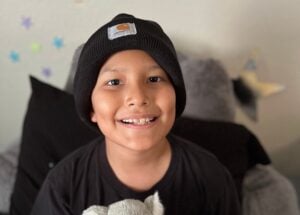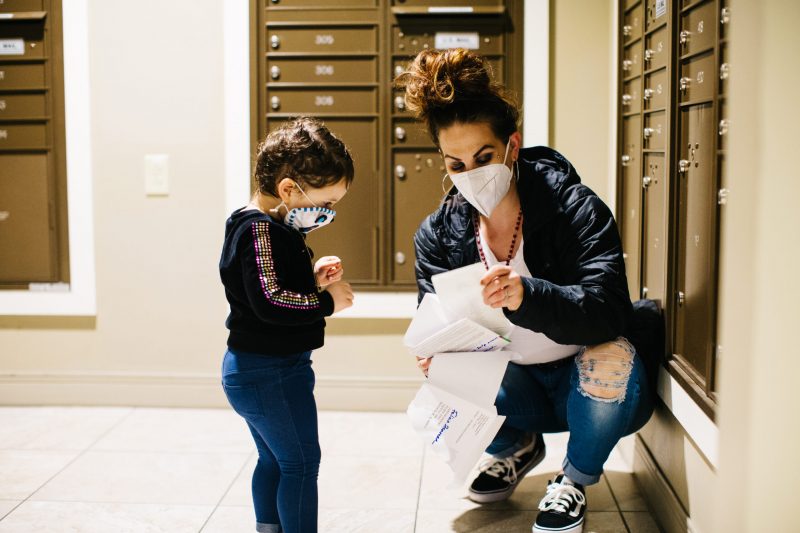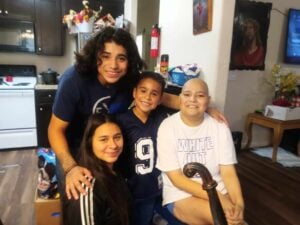
Sights Set on a Strong End to 2023 — Will You Join Us?
Family Reach CEO Carla Tardif reflects on 2023 and calls for community support before the year ends.
A brilliant team of scientists could cure cancer tomorrow and yet most people wouldn’t be able to afford the life-saving treatment.
Currently, 1 in 3 Americans put off getting medical treatment that they or a family member needs because of cost.1 This means the affordability of cancer care can make or break a patient’s chance of survival, especially when it becomes a significant barrier to treatment.
Family Reach understands the many costs of cancer, and much of that knowledge comes from the lived experiences of the families we serve. We know that since treatment began, 91% of them have lost 25% or more of their household income and 66% have used their savings to cover their expenses.
“The system needs to better support cancer patients,” shared Andrea Incudine, MPH, Director of Impact at Family Reach. “In 2021 alone, we have seen almost 900 families at risk of houselessness. No family should ever have to choose between their health and their home. More importantly, the system shouldn’t let this even be a possibility.”
While we can’t fix the entire system, Family Reach is here to help families with our free financial support services. Through collaboration with others involved in the cancer care continuum, we’re invested in addressing gaps in affordability and making the healthcare system more whole.
Cancer takes an incredible financial toll on families, often from the combination of missed work due to treatment demands and increased out-of-pocket expenses.
This financial toxicity is something that oncologists and researchers like Fumiko Chino, MD consider in their interactions with patients and hope others on the care team address as well.
“As a practicing oncologist, the affordability issues that patients deal with on a day-to-day basis, I also see on a day-to-day basis,” said Dr. Chino. “It’s a real issue and it’s very pervasive, ultimately affecting patients’ ability to receive care.”
With so many costs and consequential outcomes to consider, it’s important to focus on ways we can make cancer care more affordable for anyone facing a diagnosis. Of course, the affordability crisis isn’t a weight anyone should carry alone, but rather a shared burden that’s tackled with collaboration and collective impact.
Through initiatives like the Affordability Moonshot, powered by Costs of Care, we can bring together diverse voices in the cancer community, including patients, survivors, caregivers, healthcare professionals, cancer nonprofits, and other like-minded partners. During a recent session of the Affordability Accelerator, Family Reach staff and family advocates joined Dr. Chino, Dr. Reshma Gupta, MD, MSHPM, lead organizer for Affordability Accelerator and Director at Costs of Care, and others in collaborative conversations.
For Dr. Chino, one of the most memorable aspects of the event was that “nobody was there to say no, nobody was there to say it wasn’t feasible, it was an open forum of ideas for true diversity in solutions.”
It's nobody's responsibility to coordinate the "big picture" of health care delivery OTHER than the patient, —the person who is the least qualified and least supported. This is fundamentally flawed.
— Fumiko Ladd Chino, MD (@fumikochino) September 18, 2021
Thoughts today from the @CostsofCare @FamilyReach #AffordabilityAccelerator pic.twitter.com/72kqB7hOgn
The attendees had a series of small group discussions, thinking about everything from parking vouchers to childcare in hospitals as they focused on how to tackle the financial harm that is a reality for many of those who go through cancer.
“The passion and lived experience in the room was palpable,” said Dr. Gupta. “As navigators, cancer survivors and warriors, managers, and executives — we all experience similar struggles in gaining transparency and navigation into the price of our own care and the care for our families.”
As we tackle the affordability crisis of cancer together, we look to a future where financial treatment begins as soon as medical treatment does.
While many in the cancer care community know the problem of financial toxicity well, a family who just received the news about their diagnosis isn’t thinking about cost until treatment is underway and their money concerns start to get in the way of healing.
This is why conversations about the cost of care can be critical to treating the financial side effects of cancer.
“We can’t forget about affordability,” said Dr. Chino. “We have to normalize these conversations on both sides of the stethoscopes.”
This simple intervention can open the door to various forms of relief for patients and their families, such as financial support from free resources or reduced anxiety after opening up about cost concerns.
“Every year I have practiced medicine, I have noticed that other healthcare workers are opening up to these conversations more,” said. Dr. Gupta. “We hope to see the divide narrow between the desire to have cost conversations and having them.”
Talking about the cost of care also includes multidisciplinary, collaborative forums like the Affordability Accelerator. As those discussions continue to spark new ideas, pilot programs are the critical next step to test interventions and present evidence-based solutions that health systems can execute on a larger scale.
According to Andrea Incudine, MPH, Family Reach’s Director of Impact, “this approach allows us to see how certain services or partnerships are received by our families and gives us the space to work through the implementation, gather real feedback from the participants, and adjust the program as needed.”
These pilot programs are key to expanding Family Reach’s services, which offers free financial education, resource navigation, financial coaching, and emergency relief grants to families facing financial hardship during cancer.
Pilots are also opportunities to focus efforts on specific elements of the causes and effects of affordability, such as location or food insecurity. This supports the addition of targeted solutions to general interventions for a deeper impact on a community and individual level.
When it comes to identifying gaps in cancer care, access and affordability are universal problems. Still, we can’t rely on one-size-fits-all solutions. There are different services and delivery methods that will work for one community more than another, and true equity in cancer care requires solutions that reach anyone who needs them, in the way that best serves them.
“The first step to improving equity is being aware of where the fault lines are. The next step is figuring out how we can fill the fault lines rather than leaving gaps between the haves and have nots in cancer care,” said Dr. Chino. “We need to assess for barriers to care from social determinants of health more frequently and think about what we can do in our capacity to overcome those barriers.”
At Family Reach, for example, we know one organization doesn’t have the capacity to fix problems as complex and pervasive as financial toxicity and cancer disparities. What we can do is expand the reach of our services to underserved communities. When we get there, we will listen, learn, and adapt our services to meet those patients where they are.

Along the way, we will prioritize collaboration with organizations like Costs of Care and other community partners so we can combine expertise and move forward with greater speed and effectiveness.
“We need to address patient out-of-pocket costs on a larger scale and with urgency because the struggle of tackling financial harm is only getting harder,” said Dr. Gupta. “We believe the collaboration will grow and we plan to disseminate our ideas from the Affordability Accelerator so health systems can begin identifying multiple opportunities to move the needle for patient costs.”
Together, we will contribute everything we can to a future of accessible and affordable cancer care.
Resources
1. Riffkin, Rebecca. “Cost Still a Barrier Between Americans and Medical Care.” Gallup, 14 Feb. 2019

Always walking the fine line between her right and left brain, Stevie brings her creative and strategic thinking to her role as Senior Creative and Brand Manager. Her work amplifies Family Reach’s voice and brings attention to the financial impacts of a cancer diagnosis.

Family Reach CEO Carla Tardif reflects on 2023 and calls for community support before the year ends.

Your holiday giving provides financial relief to families like these who are facing cancer this winter.

Curious what a donation to Family Reach does? Here’s a breakdown of how donations to Family Reach provide financial support to families facing cancer.
Applications will only be reviewed and processed for open funds.
Applications will only be reviewed and processed for open funds.
Applications will only be reviewed and processed for open funds.
Applications will only be reviewed and processed for open funds.
Applications will only be reviewed and processed for open funds.